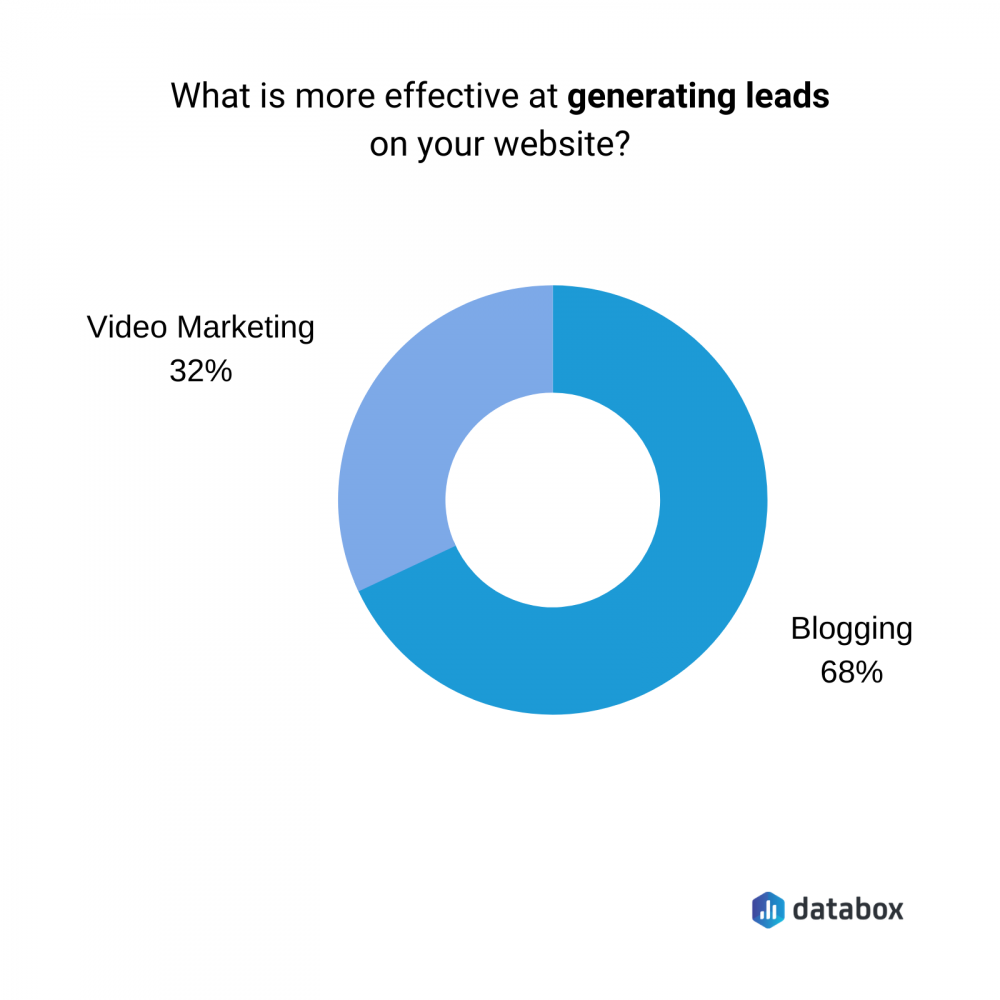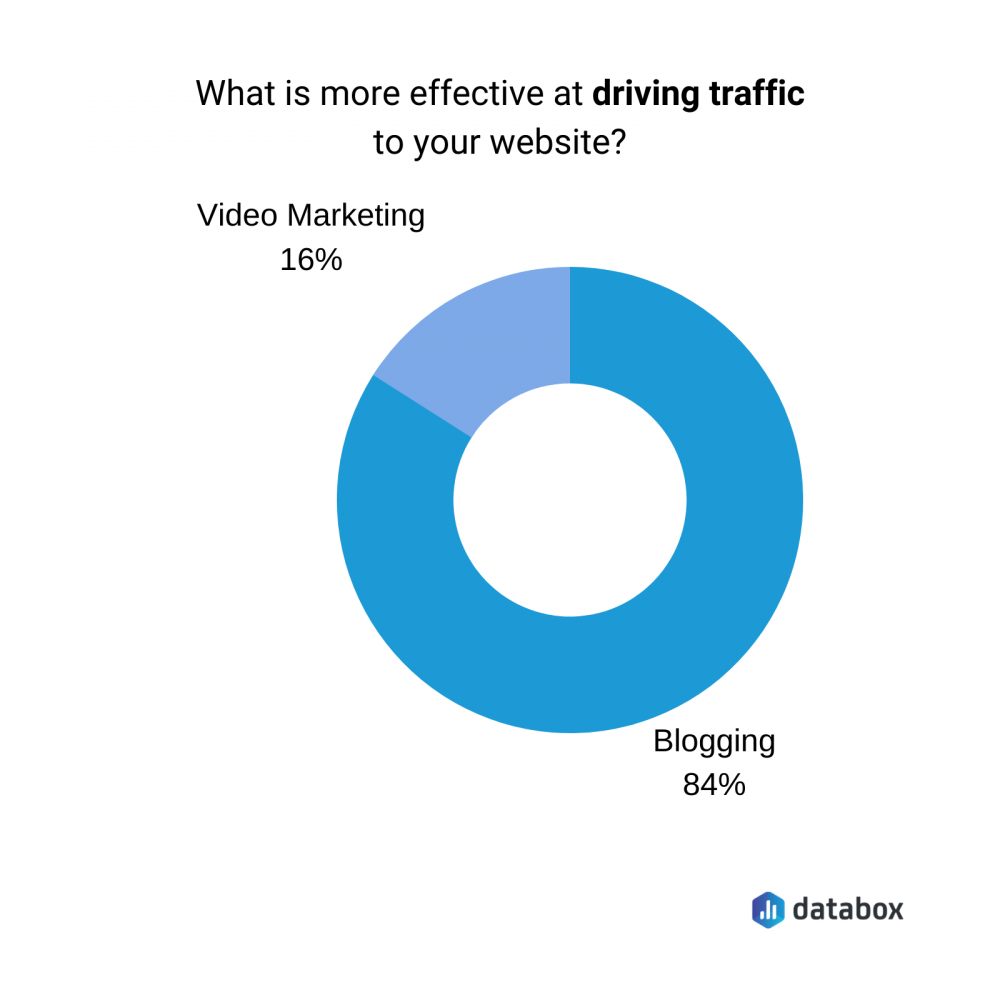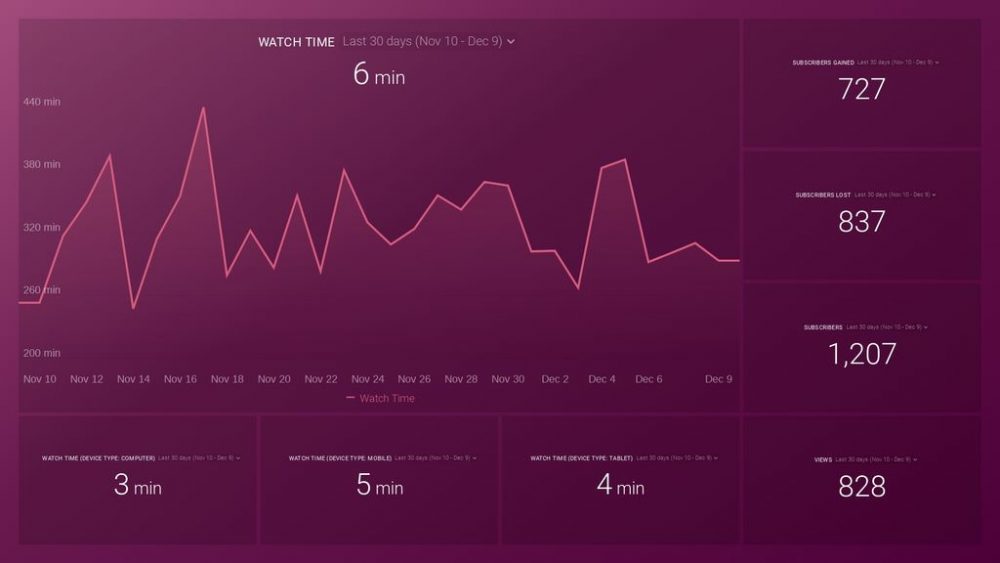Table of contents
As a marketer with a limited budget and time, which marketing strategy should you invest in 2021 and beyond?
Are people even reading long-form blogs anymore? Or has everyone shifted to vlogs, especially with the advent of platforms like Tik Tok and Instagram Reels?
What’s the tea? Where do successful brands plan to create more content in the following year?
Almost 25 marketers weigh in with their expert opinion. Let’s dig into the answers.
We’ll discuss:
- Blog vs. Vlog – What Do the Numbers Say?
- Blogger or Vlogger: Where Should You Create Content in 2021?
- Blog vs. Vlog: Why Not Choose Both?
Blog vs. Vlog – What Do the Numbers Say?
While some businesses plan to amp up their content marketing efforts in 2021, others plan to double down on videos and take advantage of the video-first world we’re in.
So let’s look at some numbers:
Blogs
- Almost 100 out of the top 200 Fortune 500 companies had a corporate blog in 2018.
- Blogs can result in a 434% increase in indexed pages and a 97% increase in indexed links.
- Companies with blogs produce an average of 67% more leads monthly than companies that don’t blog.
- 96% of companies planned to increase their content marketing budgets in 2019, and 46% had higher content marketing budgets in 2018 than in 2017.
Demographics
According to a recent report by Sysomos, 53.3% of bloggers are in the 21 to 35 years age range.
And 50.9% of them are females.
Vlog
Here are some stats gathered by Wyzowl.com.
- 87% of video marketers say video has increased traffic to their website.
- 81% of video marketers say video has helped increase the average time their visitors spend on page.
- 83% of video marketers say video has helped them generate leads.
- 80% of video marketers say video has directly helped increase sales.
According to YouGov, while 18 to 34 year olds are most likely to watch vlogs, 54% of 35 to 54 year olds are also avid vlog watchers.
And while how-to videos are the most popular type of vlogs (let’s face it, we were all at one addicted to BuzzFeed’s 1-minute Tasty videos, right?), product reviews come a close second.
Blog vs. Vlog in Numbers
We ran our own research, and we received some interesting results.
When it comes to generating leads, 68% of the marketers we surveyed selected blogging over video marketing.

And when it comes to driving traffic, blogging wins again with 84%.

Lastly, when we asked where do marketers invest more time and resources, blogging was the main focus of the majority of our respondents with a whopping 73%, and video marketing with only 16%.

PRO TIP: Measure Your Content Marketing Performance Like a Pro
Struggling to track the impact of your content across platforms? We feel you. Thanks to Databox, fragmented data doesn’t have to hold you back anymore.
Our library of free content marketing dashboard templates puts all the insights and metrics you need in one place. No more jumping between reports!
Measure engagement: Track key metrics like likes, comments, shares across social media platforms to see what content resonates most with your audience. Analyze website traffic, bounce rate, and average time on page to understand how visitors interact with your content.
Optimize conversions: Identify high-performing landing pages and blog posts that drive the most leads using dashboards like HubSpot Marketing Lead Source. Analyze campaign performance and user activity for both organic and paid content with a Facebook Pages & Facebook Ads dashboard.
Improve SEO: See which pages rank highest in search results and drive the most organic traffic. Improve search visibility by visualizing key SEO factors like backlinks and domain rank.
You can easily set it up in just a few clicks – no coding required.
To set up a dashboard, follow these 3 simple steps:
Step 1: Choose a fitting template
Step 2: Connect your data
Step 3: Watch your dashboard populate in seconds
Blogger or Vlogger: Where Should You Create Content in 2021?
We’ve got 24 marketing experts on board to help you decide which marketing tactic to invest in 2021 – vlogs or blogs.
So let’s dive right in.
Vlog
From 61% marketers using videos in 2016, to 85% marketers using videos in 2020, videos have seen a huge surge in popularity. Marketers are scrambling to create videos that convert and add them to their marketing mix.
Let’s discuss some of the benefits of using vlogs.
- Forge a better connection with your audience
- Give your landing pages a boost
- Leverage your marketing strategy with YouTube videos
- Don’t forget the benefits of live streaming
- Vlogs have stronger CTAs
- Efficiently grab your users’ attention
- More efficient storytelling
- Better product representation with review videos
1. Forge a better connection with your audience
Yoann Bierling of International Consulting shares their experience with blogs and vlogs, and says, “A year back, our website network was fully text and image-based, and we switched to try including a video per article to compliment them and to start a videocast channel to further expand video brands reach.”
Why?
Because videos add a human element, a personal touch to content that blogs can’t.
Bierling explains, “While video isn’t the priority, it is now about 25% of the time invested in created content, for a simple reason: video creates real connection with people, far more than static text or images do. Visitors are more likely to ask questions, request participating, and interact with videos than they are with standard static blog posts.”
2. Give your landing pages a boost
Want to amp up your landing page conversions?
Of course you do.
A great way to do that is by adding videos to your landing page.
As Catriona Jasica of Top Vouchers Code says, “If you are struggling with driving traffic to your webpage, then trust me, you are not alone. Sometimes, it happens that the engagement on your website becomes stagnant. Many content professionals are challenged with knowing what is most important to their audiences.
However, taking advantage of video marketing by using gated content and adding videos to your landing page will surely elevate your business to the next level.”
3. Leverage your marketing strategy with YouTube videos
YouTube users are highly engaged. They watch an average of one billion hours of video every day.
If you still haven’t started using YouTube for video marketing, you’re missing out big time.
John Frigo of Best Price Nutrition shares his experience with using YouTube for video marketing and says, “We had a YouTube channel years ago which kind of went dormant. We recently started to revive that channel. We mainly make videos announcing new products coming out, but we also do product reviews and provide some information and education about supplements as well.
Not only do these videos tend to rank really well in Google but they also are a great way for us to interact with our customers and potential customers and answer questions. Youtube is our main content venue but we also do a fair bit of blogging and have begun a podcast.”
Editor’s note: Use this free YouTube Watch Time Performance Dashboard Template to measure and analyze the total amount of time viewers spend watching your videos on Youtube.

Related: Use These 11 YouTube SEO Tips to Improve Your Search Rankings
4. Don’t forget the benefits of live streaming
“Each week I go live on Facebook with content marketing training. This was the first piece of consistent weekly content that I started for my business. From that live content, I am able to download it and upload it to YouTube to post in other places as well, like on LinkedIn and embedded on my website. Many times, I take the same content and turn it into a blog and a podcast.
At the end of every video and blog, I include a call to action that encourages my audience to download a freebie with additional content.
The more I promote the videos, blogs and freebies, the more traffic and leads I get.
I follow up with those leads using a welcome series and then weekly emails to encourage them to join more Facebook live trainings.” Shares Wendy Margolin of Sparkr Marketing
5. Vlogs have stronger CTAs
Did you know 46% of users take an action (CTA) after viewing a video ad?
But what if a video doesn’t have a strong enough CTA?
You miss out on a big percentage of warm viewers who are ready to press that ‘Sign Up’, ‘Shop Now’, or “Learn More’, button.
SyncShow’s Jasz Joseph shares, “Adding calls to action to our videos has been a great lead driver. We use the Vidyard HubSpot integration to do this but there are a variety of tools that allow you to add buttons to your videos. As users are watching, they are prompted to reach out to us to learn more.”
6. Efficiently grab your users’ attention
“For us, the effectiveness and impact of video marketing has been undeniable. Simple as it sounds — users are intrigued by video. As long as they find something captivating about what they’re watching, they’ll want to watch more. And as long as they’re willing to watch more, you now have a captive audience willing to learn more about your company, product, or brand.
Given how impactful video marketing is, we focus on producing quality videos with strong, attention-grabbing imagery off of the top. We know that we don’t have a lot of time to capture users’ attention, so we aim to keep our videos short — 30 seconds max. We always pair our videos with strong copy, a call-to-action, and a link to a landing page. From there, we often present a full-length video and more in-depth copy.
We not only post our videos as standalone ads, but we also invest in pre-roll advertising on Facebook and YouTube.
When it’s all said and done, the audience is there. Research clearly points to the fact that more and more people are watching videos on social media. Our job is to capitalize on that by producing the highest-quality pieces possible. If we can focus on that, the rest will follow.” Explains Vickie Pierre of VeteransAutoInsurance.com.
7. More efficient storytelling
You can’t just create a video, upload it, and then wait for engagement and leads to come flowing in. You need to create a strong effective process where you’re optimizing your videos for maximum performance.
Wistia’s Meisha Bochicchio shares that they use video to drive leads through webinars and customer success stories.
“We lean heavily on storytelling with these videos and also use player add-ons like embedded links and calls-to-action to drive viewers further down the funnel. We then pair the video with text-based summaries so visitors can easily scan the page to get the most relevant information. This approach has worked really well for our team, and we plan to invest even more in video assets in 2021.” Says Bochicchio.
8. Better product representation with review videos
What’s better than a written product review?
A product review video!
“We are adding video content to our written reviews of digital products as a way to improve conversions on any of our ‘review’ pages. For readers who are interested in the product we are reviewing, being able to have an exclusive ‘peek under the hood’ is absolutely KEY to conversions.” Explains Kristine Thorndyke of Test Prep Nerds
Timmy Yanchun of LTHR Shaving agrees and says, “Videos can provide a much better representation of our products, and also answer questions where an FAQ page would just fall flat.
Plus, we are right in the middle of a digital age, so why not embrace that technology?”
Exactly.
Blog
Now let’s take a look at some benefits of using blogs for marketing.
- Increase organic traffic
- Bring your audience value
- Blogs are easier to optimize for SEO
- Answer audience’s burning questions
- Find a unique angle
- Use blogs for guest posting
1. Increase organic traffic
“At Growth Hackers, we use blogging extensively. In fact, we share well-researched, insightful blog posts a week on our blog. Why? Because blogging is a great way to increase our organic traffic, build our authority, generate leads and sign new customers.” Aptly explains Jonathan Aufray of Growth Hackers Marketing.
2. Bring your audience value
Solve your audience’s problems through content.
Address their pain points and offer solutions.
Ease their life.
Instead of talking about all the great things your business can do, write informative posts that provide value to your audience.
Luke Smith of We Buy Property In Kentucky shares, “We’re using our blog to write information that adds value to our traffic. The topics are related to our industry (real estate), but they don’t just discuss working with us.
They inform the audience of options to improve, sell, rent, finance or manage real estate. We have a wide variety of topics that we cover and they’re all geared toward bringing our audience value rather than converting them to a lead.”
And what happens when you provide value to your audience?
“If we add value to them, then we see them follow our link to the home page and potentially work with us.” Adds Smith.
3. Blogs are easier to optimize for SEO
“Our team utilizes blogging quite a bit in order to drive new traffic to our site and convert them into leads. When we are creating blogs, we always perform research beforehand in order to find the best keywords/questions to include within our blogs. If you focus on good, high-quality keywords, you have the ability to rank for these keywords and gain this traffic.
Also, if you perform research on which long-tail questions are being asked on Google and answer these questions within your blog, this can be a great way to acquire the featured snippet in Google and drastically increase your traffic.” Shares Colin Mosier of JSL Marketing & Web Design.
Bruce Harpham of SaaS Marketing Services is of the same mind and says, “My process starts by analyzing promising keywords that competition websites are ranking for. If the SEO competitiveness level for those keywords is reasonable, I then create high quality blog content to rank for that keyword.”
Apart from adding keywords, what else can you do to optimize your blog post?
Milestone Localization shares, “Adding links to specific pages. Sharing blogs on relevant groups. Sharing the link to people who are already following the forum related to our blog topics.”
And as Melanie Musson TheTruthAboutInsurance.com aptly concludes, “We focus strongly on blogging and strive for a perfect blend of SEO focus and engaging content. It’s important to have both. SEO helps your audience find you, but engaging content keeps your audience with you.
Once you’ve captured your audience you’re one step closer to a conversion.”
4. Answer audience’s burning questions
Mudassir Ahmed of Blogging Explained recommends businesses to, “List out the burning queries that your audience might have, using platforms like Quora or keyword research tools. Organize your expertise to present exclusive advice to them by writing blog pots.
Offer a solution and don’t try to push your products in your content. The more often you do it, the more credibility your brand will get, and then it will be easier to convert the traffic into qualified leads.”
Elijah Litscher of The Loop Marketing agrees and adds, “We focus on what our site visitors are looking for and the questions we can answer.
Because Google can’t necessarily read videos (at least, not yet), we focus our efforts on high-quality blogs that answer the questions they need answers to.”
5. Find a unique angle
Mateen Khan of PureVPN advises businesses to add value through their blog content.
“After carefully selecting the topic and content type, it’s time for us to think about how you can position your content to stand out from all the rest.
The reality is that there are probably many posts on other blogs that are talking about something similar.
The key is finding that element that separates your content from all of the rest.
That might mean finding a unique angle, including more depth, adding more detail, improving the usability, or just giving away more information.” Explains Khan.
6. Use blogs for guest posting
“Blogging can be used in numerous ways to drive traffic, but guest posting is a very successful strategy.” Explains Al McMordie of Big Al’s Sports Picks.
“When your site is still climbing the search engine pages, then it’s extremely beneficial to negotiate guest posts on higher-traffic websites, where you can benefit both from their search engine rankings and the opportunity to place your content in front of a new audience.”
Blog vs. Vlog: Why Not Choose Both?
To really amp up your marketing in 2021, marketing experts suggest investing in both, blogs and vlogs, together.
Isabella Mello of Hearst Bay Area explains, “Our team publishes a robust blog, creating valuable content for potential customers. We amplify our blog with video marketing — creating one-minute ‘key takeaway’ videos that we use to boost our SEO and on-page engagement.”
These bite-sized videos can then be used for social media marketing to drive more traffic to the blog. As Mello adds, “Blogging and video marketing work together to boost audience engagement and SEO. With higher visibility and quality content, we are able to drive leads.”
Niles Koenigsberg of FiG Advertising + Marketing is of the same mind as Mello and believes in creating a solid blog post first and then turning it into multiple videos for social sharing.
“Our team will take the blogs that we create and re-purpose them into short videos (no longer than 2 minutes) that are visually interesting. We rely mostly on stock footage for those videos, but each video is appropriately branded for the client and touches on the key points of each blog.
We will then publish those videos on our clients’ social feeds (e.g., Facebook, Instagram, YouTube, etc.). And while these videos aim to engage the brand with their followers and we hope to acquire some site traffic from them, they are not our main driver of new leads.” Explains Koenigsberg.
Luke Niemela of Vye does the opposite. She advocates creating a robust video first and then cutting them into smaller videos for social media and blogs.
“First, we create a full-length video to tell a story. We then slice that video up to create several shorter videos. These shorter videos are posted in blogs and on social media to drive traffic back to the original video, a specific webpage, or a form. It depends on where we want more traffic generated or leads to come from.” Shares Niemela.
Alex Cascio of Vibrant Media Productions shares that they make a constant push to release blog and video content consistently several times a week on all their marketing platforms.
“When we start a project for a client we now set aside time to make sure we take notes for blogs/case studies and shoot video content (behind the scenes)/project footage, as it has shown to be very valuable.
A blog mixed with video as a summary at the top (30-60 seconds) have shown strong engagements throughout our website posts. Both blogs and videos are strong on their own to drive traffic/leads – but doing both is a strong way to drive traffic on your website.” Says Cascio.
Electric Enjin’s Morgan Hennessey aptly says, “It’s important that we realize that everyone digests content in different ways.
It’s a shame to spend hours planning, researching, writing, editing, and producing content for someone to write it off for not being their preferred form of media. We will use all of those time and resources to create great blog content, and then segment that copy into an outline for a podcast (which we can record and turn into a vlog), and then microsegment the content further into infographics, social posts, etc.
We’ve created, at the bare minimum, 3 pieces of content at the end of this process which will not only bring more users to our website and social profiles, but increase the chances of our content being shared and gaining backlinks and referral traffic.”
While some marketers and businesses prefer spending all their time on either blog posts or videos, most prefer spending equal time on both to reap the maximum benefits.
Wrap up
“No matter if it’s through blogging or video marketing, the concept is still the same – create valuable content that will drive users where we want them (whether it’s a service, product, or email list).” Aptly concludes Dylan Gordon of HustlerSource.
















